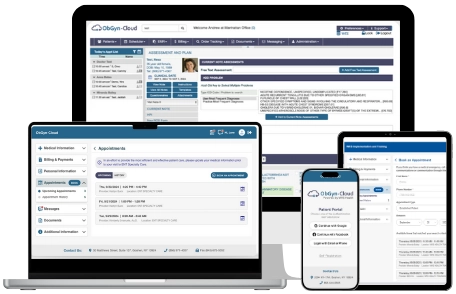Key Takeaways
- Outdated OB templates quietly drive up costs through inefficiency, billing errors, and lost time.
- AI‑enabled, OB‑specific templates deliver smarter charting, better billing accuracy, and durable financial savings.
- Investing in specialty tools not only pays off in operational ROI, it frees your team to do what matters most—care.
- Leverage ObGyn-Cloud’s AI-enabled EHR to stay ahead in medical billing.
In many women’s health practices, documentation feels like running uphill. Generic, legacy templates—designed for all specialties—force providers to click through fields that don’t apply or hunt for prenatal-specific tools. The result? Charting takes longer, errors creep in, and front‑desk processes slow to a crawl.
These inefficiencies cause operational headaches, and they cost practices money. Billing mistakes lead to denials. Staff time gets eaten by unnecessary navigation. And provider frustration mounts. If even small delays or inaccuracies happen for each prenatal visit, the cumulative effect is a steady, silent bleeding of time—and revenue.
Table of Contents
Repetitive documentation tasks are a major time sink in OB/GYN clinics. Every prenatal visit, Pap smear, and procedure comes with detailed reporting and coding requirements. Manual entry slows your team down and can also lead to errors or missed revenue.
Specialty Templates Are Nicer—and Smarter
Specialty-designed OB/GYN templates make every click count. Tailored to prenatal care, surgical workflows, and gynecological exams, they remove irrelevant noise and keep your focus where it belongs. Customizable templates are a source of untapped potential to speed up the charting process by minimizing clicks and presenting only relevant fields. In the case of speciality healthcare, less is more.
How Much Are Outdated Templates Really Costing You?
Sticking with generic templates doesn’t save you money—it increases your operational costs. Here’s how:
- Increased Charting Time: Wasted minutes per patient add up. Even 5–10 minutes extra per women’s health visit means hours lost each week.
- Billing Errors & Denials: Without OB/GYN-focused fields and coding prompts, mistakes are common—and costly. You may bill incomplete or incorrect codes that get denied post-submission.
- Staff Burnout and Turnover: Frustration with clunky templates pushes talented staff members out the day. Hiring and training new team members is far more expensive than investing in better workflows.
- Compliance Risk: Missing prenatal-specific documentation can trigger audits or fines—another bill you don’t want to pay.
Smart Charting OB/GYN: How AI Templates Deliver Value
Enter the smart, AI-enabled OB/GYN EHR: with templates designed to understand OB workflows and adapt to your charting style.
- Adaptive, Prenatal-Aware Templates: These evolve based on encounter type—prenatal visit? The tool instantly offers fetal growth, gestational age, and relevant exam fields. No hunting required.
- Context‑Sensitive Prompts: AI recognizes patterns in your notes and suggests the next field—saving clicks and minimizing omissions.
- Error Prevention: AI alerts you if documentation doesn’t align with expected prenatal or GYN coding guidance, reducing ENT billing mistakes and avoiding costly denials.
- Fewer Clicks, More Context: By serving only what’s relevant, modern charting keeps your workflow lean and focused.
Can Investing in OB Template Upgrades Actually Pay Off?
The core question for any practice leader is this: Is it worth investing in specialty OB/GYN tools—or should we just make do?
Yes—it is. And it’s been proven that comprehensive templating and structured workflows provide a foundation for scalable care delivery. A system that prompts the right documentation, reduces billing errors, and enables seamless charting saves significant provider time and revenue. That time recovers faster than staffing new hires, training existing teams, or repairing revenue losses from repeated denials.
Real Savings From Smarter Charting
- Faster Documentation: Providers regain minutes per visit and hours per week. That’s more patient care—or a shorter workday.
- Fewer Denials: Accurate coding built into templates stops mistakes before they become claims, preserving revenue and reducing administrative cleanup.
- Reduced Onboarding Time: New staff get up to speed faster when workflows make sense—saving on training overhead.
- Lower Compliance Risk: Automated documentation checks keep you audit-ready, reducing the chance of fines or compliance disruptions.
The Real ROI: Cutting Costs Without Cutting Care
Modern women’s health practices don’t have to choose between cost controls and compassionate care. An AI-powered, specialty-focused OB template can ensure both.
- You chart less and chart better.
- You bill cleaner and get paid faster.
- You maintain high care standards without administrative overload.
That’s the heart of reducing healthcare costs in OB/GYN: not by cutting corners, but by aligning technology with specialty needs, so your practice runs smoother, smarter—and remains patient-focused.
Reduce Healthcare Costs in OB/GYN










